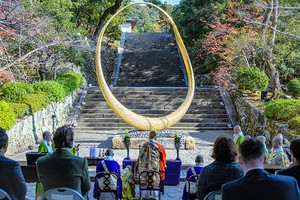February 29, 2024 at 14:48 JST
 Stablemaster Miyagino, left, meets with reporters while his disciple, Hokuseiho, bows in apology on Feb. 23 in Tokyo’s Sumida Ward. (Kai Uchida)
Stablemaster Miyagino, left, meets with reporters while his disciple, Hokuseiho, bows in apology on Feb. 23 in Tokyo’s Sumida Ward. (Kai Uchida)
Once again, a scandal of violence has emerged in Japan’s professional sumo world.
Any form of malicious and mean violence or bullying must have no place in sports training whatsoever.
A makuuchi division senior-grade wrestler from the Miyagino stable, 22-year-old Hokuseiho, was found to have committed various violent acts against his two junior stablemates.
Hokuseiho reportedly punched the faces, backs and groins of the junior members of the stable and knocked them down.
The senior wrestler also hit their buttocks with a mawashi (sumo belt) tied into the shape of a log as well as brought a flame close to their bodies by igniting insecticide spray. It was also reported that he once applied instant glue to their fingers.
These violent acts continued for over a year from around July 2022 to November last year, occurring in the stable's Tokyo location and lodgings during regional tours, repeating two to three times a week.
Miyagino, the “oyakata” stablemaster, or retired yokozuna Hakuho, became aware of what was going on in the summer of 2022 but failed to question the victims to confirm the facts, warn the perpetrator, or report the case to the Japan Sumo Association.
It is unclear whether Miyagino’s inaction toward his disciple’s violent acts was due to favoritism for Hokuseiho, who was seen as a promising wrestler with the tallest height in sumo at 204 cm, or because the stablemaster did not want to lose his status.
In any case, neglecting supervisory responsibility and the duty to report such a case to the sumo regulating body was a grave mistake.
Considering the physical and mental wounds suffered by the victims, the association has every reason to take severe disciplinary actions against both the abuser and his stablemaster.
Hokuseiho has been effectively expelled from the sumo world, and stablemaster Miyagino has received a demotion of two ranks within the association and a salary reduction.
However, the abuse scandal has broader implications for the association and the sumo world, requiring actions beyond merely punishing these two individuals. The association’s stance toward the training culture fraught with problems should be questioned.
In 2007, a young sumo wrestler died from severe beatings by his stablemaster and fellow wrestlers acting under the oyakata’s instructions. The tragedy was made worse by deliberate attempts to conceal the victim's cause of death.
In 2017, a yokozuna, the absolute highest rank in sumo, was forced to retire after assaulting a junior wrestler.
In response to the disturbing incident, the association established a compliance committee, including external experts, and set up various regulations for prevention, including rules for disciplinary actions.
However, cases of punishment for violence by stablemasters and wrestlers have continued arising even after the compliance reforms.
It's likely that many parents feel uneasy about entrusting their children to such a community for their pursuit of a career as professional sumo wrestlers.
In recent years, an increasing number of university graduates and foreign-born rookies have joined the world of professional sumo. Still, the fact remains that both wrestlers and stablemasters grow up in a close-knit society dominated by strict hierarchies and strong ranking consciousness.
The environment of a martial art also inherently contains factors that could lead to violence or bullying.
To prevent such acts, it is vital to strengthen community oversight with experienced and knowledgeable supervisors and transition from traditional customs and coaching methods toward healthier and scientific ways to train and develop wrestlers.
While meeting certain criteria, such as the number of tournaments spent in the makuuchi division, grants a retiring wrestler the qualifications to become a stablemaster, what should be truly required is the aptitude as a coach and stable operator.
Having a diverse set of coaching and management skills, including scientific approaches, is a must for modern professional sports coaches. In one encouraging sign, some stablemasters have enrolled in graduate schools to learn coaching science and management.
The association should clearly demonstrate a wholesale commitment to improving the qualifications and education of stablemasters across the board.
--The Asahi Shimbun, Feb. 28




















A peek through the music industry’s curtain at the producers who harnessed social media to help their idols go global.
A series based on diplomatic documents declassified by Japan’s Foreign Ministry
Here is a collection of first-hand accounts by “hibakusha” atomic bomb survivors.
Cooking experts, chefs and others involved in the field of food introduce their special recipes intertwined with their paths in life.
A series about Japanese-Americans and their memories of World War II